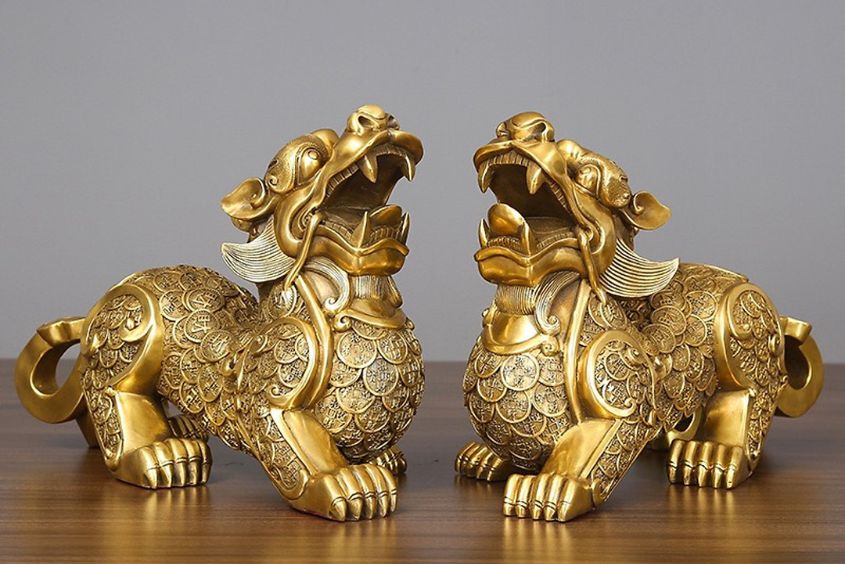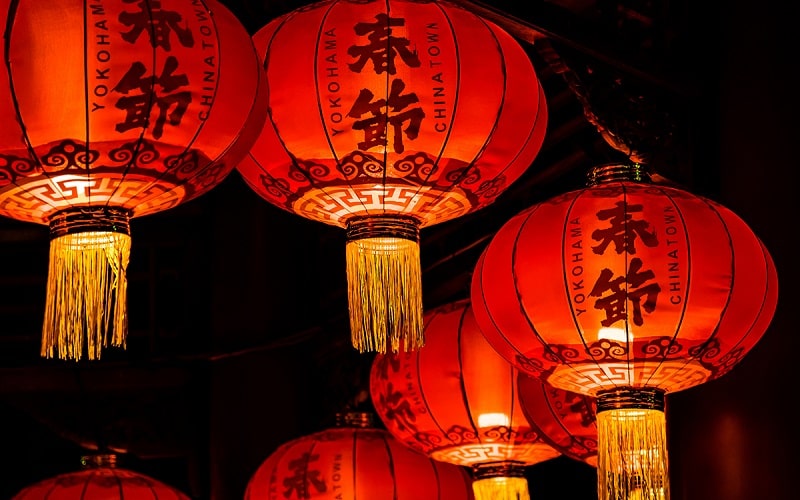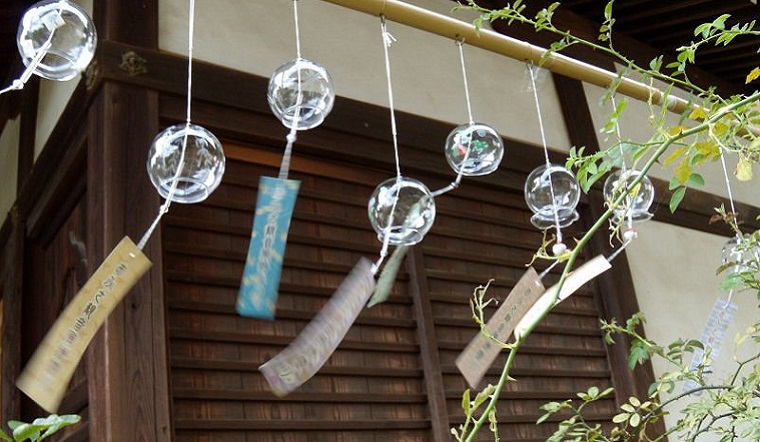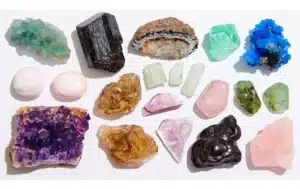In the ancient and sophisticated practice of Feng Shui, various symbolic objects are thoughtfully employed to tap into the auspicious flow of universal energies. These items serve as tools to harmonize and enhance the ‘Chi’, or life-force, within one’s environment, thus promoting an array of beneficial outcomes. In this article, LotusBuddhas will provide useful information about ten notable feng shui items traditionally used to attract luck and wealth.
What is a Feng Shui item?
A Feng Shui item is a tool used to adjust the energy, or Chi, within a space to achieve harmony, balance, and prosperity, according to the principles of Feng Shui. Originating from ancient China, Feng Shui is a practice that involves arranging the physical environment in accordance with energy flows. Feng Shui items come in many forms, from crystals and mirrors to wind chimes and statues.
These items serve to either enhance positive energy or cure negative energy within a space. They are selected based on their inherent characteristics, their symbolism in Chinese culture, and their specific purpose within the Bagua, the Feng Shui energy map of a space. The Bagua consists of nine areas, each relating to a different aspect of life, such as wealth, health, family, or personal growth.
Using a Feng Shui item effectively requires more than simply placing it in a room. It involves careful selection of the item, mindful placement, and a clear intention. The item must be suitable for the intended purpose, positioned in a way that aligns with the principles of Feng Shui, and used with a focus on achieving a specific goal or change.
For example, a mirror can be used to reflect and double good fortune or to draw in beneficial Qi, but it can also be used to deflect negative energy. The mirror’s shape, size, and placement are critical factors that determine its effectiveness.
Similarly, a wind chime can circulate energy and break up stagnant Qi, promoting a positive energy flow. The material, design, and location of the wind chime are vital considerations.
You must to remember, the power of a Feng Shui item is not just in its physical presence, but also in the mindful intention behind its use. When used correctly, these items can become powerful tools to balance energy, harmonize spaces, and positively influence various aspects of life.
1. Wealth Ship
Wealth ship is a popular symbol used in the traditional practice of Feng Shui to magnetize wealth and good fortune. This significant emblem is believed to carry the connotation of affluence, opulence, and prosperity that navigates towards you, thereby bringing in riches and amplifying financial success.
Intricately designed, the wealth ship usually features a wooden ship loaded with gold coins, ingots, jewels, and other forms of wealth, symbolizing an incoming shipload of blessings and prosperity. The shape, design, and aesthetics of the wealth ship all play significant roles in creating the energy patterns which attract wealth and abundance. The beauty of the ship, the shine of the gold, and the intricate detailing of the precious gems all contribute to the visual appeal and energetic allure of the wealth ship.
In the context of Feng Shui, water is associated with the flow of wealth. Therefore, a ship sailing on the water represents the transportation of riches, and positioning it correctly ensures that the ‘wealth energy’ moves into your home or office, instead of flowing out. Traditionally, the wealth ship is placed in the money area of your home or office, such as the southeast sector according to the Bagua map, or in the vicinity of cash registers or desks where financial decisions are made.
The wealth ship is typically placed sailing inwards, not outwards, signifying the influx of wealth and fortune. It should never be displayed sailing outwards, as that could suggest wealth sailing away or being lost. Therefore, be very careful with the direction of placement.
Remember, Feng Shui is about harnessing positive energy and balancing the ‘Chi’ or life force. The wealth ship is not just a symbol, but a powerful tool to align with this cosmic energy. It is the intentional placement and the belief in the symbol that activate the wealth-enhancing energies of the wealth ship.
Feng Shui is not merely about placing objects; it is a philosophical system that requires understanding, faith, and mindfulness. So, when you position your wealth ship, do so with sincerity, gratitude, and an open mind. With this, you can invite wealth, prosperity, and financial stability into your life. The wealth ship, in its alluring charm and symbolic potency, serves as a constant reminder of abundance, encouraging you to set sail on the voyage of prosperity and fortune.
2. Pixiu
Pixiu or “Pi Yao” in Chinese, is a captivating creature highly revered in the practice of Feng Shui for its potency in attracting wealth, good luck, and positive energy. With its fierce dragon-like head, lion’s body, and mythical wings, the Pixiu is a powerful talisman recognized for its voracious appetite for gold and its ability to trap negative energy.
One of the key characteristics of the Pixiu that separates it from other Feng Shui symbols is its unique mythology. It is said that the Jade Emperor, a high deity in Taoism, punished Pixiu by sealing its rectum after it defecated on the floor of Heaven. Consequently, Pixiu can ingest wealth but never dispel it, symbolizing the accumulation of riches.
The Pixiu is also known for its protective qualities. Its fierce visage and powerful form can ward off evil spirits and harmful forces. It’s believed to have the power to transform negative ‘Chi’ into positive energy, making it a symbol of protection and transformation.
In Feng Shui, Pixiu talismans are often crafted from gold, jade, or bronze and may be used as pendants, bracelets, statues, or charms. They can be placed in various locations depending on their intended use. To attract wealth and good fortune, a Pixiu talisman can be positioned facing the entrance of your home or office, or in the wealth sector (southeast according to the Bagua map) of your space.
When placing your Pixiu, it’s essential to treat it with respect and reverence, acknowledging its power and purpose. Like all Feng Shui tools, the Pixiu should be well-maintained and kept clean. Pixiu talismans should not be placed on the floor or in the bathroom, as this is seen as disrespectful and can diminish their power.
In essence, the Pixiu is more than just a mythical creature; it is a potent Feng Shui tool that guards against negativity and fosters wealth. By consciously incorporating a Pixiu into your space, you are inviting the powerful energies it embodies, creating a protective shield and a magnet for wealth and good luck in your life.
3. Three-Legged Toad (Money Frog)
The three-legged toad, also known as the money frog or “Chan Chu” in Chinese, is a cherished symbol in the ancient practice of Feng Shui, reputed to bring in wealth and prosperity. It is believed to possess the unique ability to usher in good luck, financial stability, and bountiful fortune.
The money frog is typically depicted as a bullfrog with red eyes, flared nostrils and only three legs, often seen holding a coin in its mouth. The coin is usually inscribed with the Chinese characters for “good fortune and prosperity.” Sometimes, the toad is shown sitting on a bed of coins, or surrounded by them, further emphasizing its association with wealth.
The three-legged toad is steeped in mythology and folklore. One popular legend describes it as the pet of Liu Hai, an immortal from Chinese mythology known for his wealth. The toad was charmed by Liu Hai’s gold and thus became a symbol of affluence, indicating the attraction of real wealth and monetary gain.
In Feng Shui, money frog is usually placed in the wealth sector of the house or office, which is the southeast corner according to the Bagua map. Alternatively, it can be placed diagonally opposite the entrance of the room so that it faces the door, signifying wealth coming into the home or business. However, the toad should never be placed on the floor, in a bathroom, or in the bedroom, as these placements are considered disrespectful and could dissipate its wealth-attracting powers.
When positioning the money frog, remember that it should always face inward, indicating that wealth is coming in, not going out. It should also be noted that the number of money frogs in a space should be one, three, six, or nine, as these numbers are considered particularly auspicious in Feng Shui.
The power of the money frog in Feng Shui is not simply derived from its symbolism but also from the intention behind its placement. As you position the money frog, imbue it with your intention to welcome wealth, prosperity, and abundance into your life. By fostering a genuine belief in its power, you align with the energies of wealth and prosperity it symbolizes.
4. Laughing Buddha
The Laughing Buddha, also known as “Budai” or “Hotei” in Chinese, is a cherished symbol in the practice of Feng Shui, renowned for attracting joy, wealth, and prosperity. Characterized by his joyful laughter, round belly, and jovial demeanor, the Laughing Buddha is believed to bring forth happiness, contentment, and wealth.
Often depicted in a seated or standing posture, with a large exposed belly and carrying a sack of wealth, the Laughing Buddha symbolizes the abundance of the universe. His broad smile and laughter create a positive, happy energy that can brighten any room, thus enhancing the ‘Chi’ or energy flow in your space.
The Laughing Buddha has several interpretations. His sack is said to represent wealth and prosperity, which he distributes freely, indicating our ability to tap into the boundless abundance of the universe. His exposed belly signifies contentment and satisfaction with life’s blessings, while his jolly demeanor illustrates the importance of joy and laughter in cultivating prosperity.
In practice of Feng Shui, the Laughing Buddha is commonly placed in the living room or office, where it can be seen by guests and residents, to spread its joy and positive energy. However, it should never be placed in the bathroom, kitchen, or on the floor as these locations are considered disrespectful. Instead, it should be placed at a height that is respectfully eye-level or higher.
When positioning the Laughing Buddha, face it towards the main entrance of the home or office. This is believed to ensure that it absorbs negative energy entering the premises, transforming it into positive energy. It can also be placed in the wealth corner, which is the southeast corner according to the Bagua map, to amplify the energy of abundance and prosperity.
In essence, the Laughing Buddha is more than just a statue. It is a symbol of joy, wealth, and abundance in Feng Shui. By inviting the Laughing Buddha into your space, you invite the essence of these energies into your life, allowing you to harness its positive vibrations and foster an environment of prosperity and happiness.
5. Dragon Turtle
The dragon turtle, known as “Long Gui” in Chinese, is a potent symbol used in the ancient practice of Feng Shui to foster wealth, prosperity, and courage. This extraordinary emblem is often depicted as a turtle with a dragon’s head, which combines the attributes of two celestial animals – the Dragon, symbolizing power, courage, and success, and the Turtle, representing longevity, protection, and stability.
The dragon turtle is typically made from various materials like brass, resin, or jade, and often depicted standing on a bed of coins and ingots, or holding a coin in its mouth. This emblem symbolizes prosperity, abundance, and wealth accumulation.
The combination of the Dragon and Turtle harnesses the energy of both celestial creatures. The Dragon’s potent energy is believed to bring success, courage, and determination, while the Turtle’s energy is associated with steadfastness, protection, and long life. Together, the dragon turtle symbolizes a long, healthy, and prosperous life.
In Feng Shui, the dragon turtle is typically placed in the southeast sector of your home or office, as this area is associated with wealth according to the Bagua map. Alternatively, it can be placed in the north sector, associated with career growth and opportunities.
When positioning the dragon turtle, it is essential to remember that it should face inward, toward the center of the room or building, to invite wealth and good fortune. Never place the dragon turtle facing outwards, as it may drive prosperity away.
Like all Feng Shui tools, the dragon turtle should be placed mindfully and with a clear intention. As you position it, focus on your aim of attracting abundance, wealth, and prosperity. This process of conscious intention activates the energy of the dragon turtle, aligning it with your goals.
6. Feng Shui Coins
Feng Shui coins are powerful symbols traditionally used in Feng Shui to attract wealth, abundance, and prosperity. These coins are usually round in shape, representing Heaven, with a square hole in the center, signifying Earth. This union of Heaven and Earth symbolizes the harmonious interaction of celestial and terrestrial energies necessary for holistic prosperity.
Often made from bronze or brass, these coins are usually inscribed with Chinese symbols or characters from the reign of a prosperous and successful dynasty, further emphasizing their association with wealth and abundance. Common inscriptions include phrases like “Zhao Cai Jin Bao,” which translates to “Attract wealth and treasure.”
In Feng Shui, these coins are commonly tied together in sets of three, six, or nine using a red string or ribbon, as these numbers are deemed auspicious. A trinity of coins symbolizes the harmony of Heaven, Earth, and Mankind. The practice of tying them with a red string is significant in Feng Shui as red represents the Fire element, which is associated with prosperity and good luck.
Feng Shui coins can be placed in several areas. They are often kept in wallets, purses, cash registers, accounting books, or wealth vases to attract financial success. They can also be placed in the wealth sector (southeast according to the Bagua map) of your home or office to enhance the ‘Chi’ or energy of prosperity.
When positioning Feng Shui coins, it’s important to remember that the Yang side, usually characterized by four Chinese characters, should face up, as it represents the active, manifesting principle of the universe.
However, the physical act of placing these coins is not enough. In Feng Shui, the power of intention is paramount. As you position the coins, focus on your goal to attract and manifest wealth, abundance, and prosperity into your life. This mindfulness imbues the coins with your intention, activating their energy to align with your financial goals.
7. Lucky Cat (Maneki-neko)
The Lucky Cat, or “Maneki-neko” as it’s known in Japanese, is a cherished talisman traditionally used in Feng Shui and Asian cultures to attract good luck, prosperity, and wealth. Typically, this enchanting figurine depicts a cat—often a calico Japanese Bobtail—with one paw raised in a beckoning gesture.
In the language of symbolism, the raised paw of the Maneki-neko is deeply significant. When the right paw is raised, it is believed to attract money and good fortune, while a raised left paw invites customers or good business relations. A Lucky Cat with both paws raised is said to protect wealth and bring in more of it.
Sometimes the Lucky Cat is seen holding a koban, a gold coin used in the Edo period in Japan. The coin is usually inscribed with the characters 千万両, which translate to “ten million ryo”—ryo being another Japanese currency. This symbolizes the cat’s ability to bring in enormous wealth.
Often, the color of the Maneki-neko also holds meaning. A white cat is said to bring overall good luck, a gold one attracts wealth and prosperity, while a black or dark-colored cat is believed to ward off evil spirits and illness.
In the practice of Feng Shui, the Lucky Cat is usually placed in the wealth sector (southeast according to the Bagua map) of your home or office. Alternatively, for businesses, it can be placed near the entrance or cash register to attract customers and good fortune.
When placing the Lucky Cat, ensure that its raised paw faces a door or window to “invite” good fortune into the space. Importantly, the cat should not be placed on the floor or any low-lying area as it may dilute its auspicious power.
Lucky Cat is more than a mere figurine—it’s a powerful Feng Shui symbol that embodies wealth-attracting energies. By consciously incorporating the Maneki-neko into your space, you align with the flow of prosperity and good fortune, inviting these abundant energies into your life.
8. Red Lanterns
Red lanterns, commonly known as “Deng Long” in Chinese, are auspicious symbols traditionally used in Feng Shui and Asian cultures to attract luck, wealth and positive energy. These enchanting objects are usually crafted from red silk, paper, or glass, often adorned with golden tassels and inscribed with symbols or characters associated with good fortune.
The color red is deeply significant in Feng Shui. Representing the Fire element, red is considered to symbolize good luck, prosperity, and vitality. It is believed to activate energy, promote success, and stimulate the flow of ‘Chi’, the universal life force. The light emitted from the lanterns, symbolizing the Fire element, is thought to illuminate darkness and ward off negative energy.
The shape of the lantern is also important. The round form symbolizes wholeness and infinity, representing the cyclical nature of life and the interconnectedness of the universe. The glow emanating from the red lanterns is considered to resemble the warm, auspicious light of a full moon, promoting a sense of harmony and completeness.
In Feng Shui, red lanterns are usually hung in front of homes or businesses, in the main hall, or at the entrance of rooms. They can be placed individually or in pairs to attract good fortune and positive energy. During special occasions or festivals like the Chinese New Year, it is common to see red lanterns hung in abundance, symbolizing a time of renewal, celebration, and the attracting of good fortune for the coming year.
When positioning red lanterns, ensure that they are well-illuminated and not obstructed, allowing the positive ‘Chi’ to flow freely. Importantly, lanterns should be well-maintained and replaced if faded or damaged, as this can symbolize a lack of care for prosperity and good luck.
9. Feng Shui Crystal
Feng Shui crystals are treasured tools employed in the ancient practice of Feng Shui to attract luck, wealth, and positive energy. Typically, these crystals are made from natural minerals like clear quartz, citrine quartz, amethyst, or rose quartz, each carrying its own unique energetic properties.
Crystals are revered in Feng Shui for their ability to hold, attract, and diffuse ‘Chi’ – the life-giving energy that permeates the universe. They are particularly prized for their ability to refract light into a spectrum of colors, symbolizing the harmonious interaction of the five elements (Wood, Fire, Earth, Metal, and Water), thus promoting balance and harmony in your space.
Clear quartz, often referred to as the “master healer”, is commonly used to enhance the flow of positive energy and clear out negativity. Citrine, known as the “Merchant’s Stone”, is specifically linked with wealth and prosperity. Amethyst is associated with peace, healing, and intuition, while Rose Quartz is often used to promote love, gentleness, and emotional healing.
In the practice of Feng Shui, crystals can be placed in various locations depending on their intended use. To attract wealth, a citrine crystal can be placed in the wealth sector (southeast according to the Bagua map) of your home or office. A rose quartz crystal might be positioned in the relationship sector (southwest according to the Bagua map) to enhance love and harmony.
When placing your Feng Shui crystals, ensure they are cleansed regularly to maintain their energetic properties. Sunlight, moonlight, or natural water can be used to cleanse and recharge your crystals.
As with all Feng Shui tools, it’s essential to place crystals with clear intention. As you position your crystal, focus on your desired outcome, whether it’s attracting wealth, enhancing love, or promoting healing. This intention activates the energy of the crystal, aligning it with your personal goals.
10. Feng Shui Wind Chimes
Feng Shui wind chimes, known as “Feng Ling” in Chinese, are enchanting instruments utilized in the practice of Feng Shui to attract good luck, wealth, and positive energy. They are usually composed of a series of bells, rods, or hollow tubes (typically made of metal, wood, or ceramic) suspended from a round top with a piece of wind-catching material attached at the bottom.
Wind Chimes serve as a bridge between the interior and exterior environments, connecting the energy flow between Heaven (the sky) and Earth (the ground). When stirred by the wind, the chimes produce melodious sounds that harmonize the energy (‘Chi’) in the environment, balance the Yin and Yang, and dispel negative energies.
The material and number of rods or tubes in a wind chime are significant. Metal wind chimes, often made of brass or aluminum, are used to ward off evil and attract prosperity. They are particularly effective when placed in the west, northwest, and north sectors according to the Bagua map. Wind chimes with 5, 6, or 8 rods are considered particularly auspicious as these numbers are associated with positive energy and wealth in Feng Shui.
In Feng Shui, wind chimes are usually hung at the entrance of a house or office, on a balcony, or near a window, where the wind can stir them. They can also be used to suppress or enhance the energy in particular areas of a building. For example, hanging a wind chime in the wealth sector (southeast according to the Bagua map) of your home or office can help attract financial abundance.
When positioning your Feng Shui wind chimes, ensure they are not obstructed, allowing the ‘Chi’ to flow freely. The chimes should be well-maintained and replaced if they become damaged, as this could symbolize neglect for prosperity and good luck. Remember, Feng Shui wind chimes are more than mere decorative items; they are potent tools to harmonize and enhance the ‘Chi’ in your space.
In sum up, this compelling array of feng shui items, steeped in rich symbolism, offers intriguing avenues to enhance the flow of prosperity and good fortune. Each item is more than a mere object; they are potent tools to align your personal energy with the greater flow of the universe, inviting an abundance of wealth and luck into your life.















